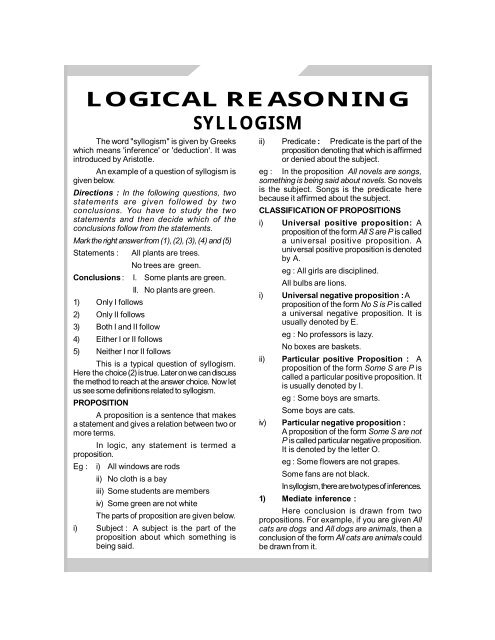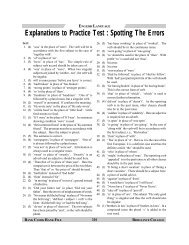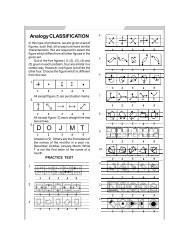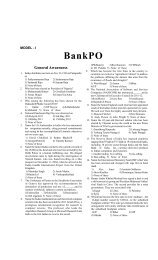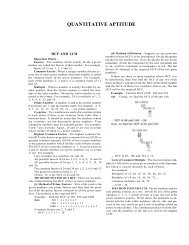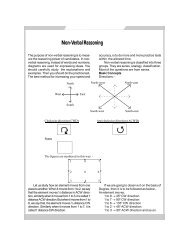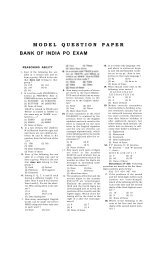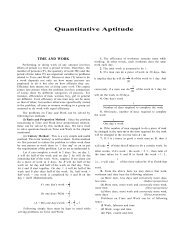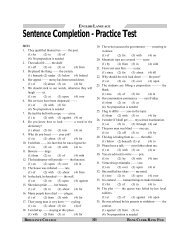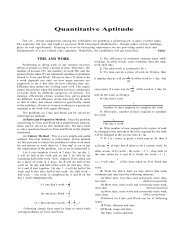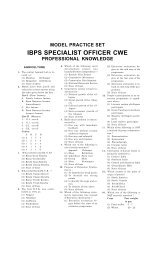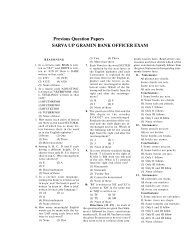LOGICAL REASONING
LOGICAL REASONING
LOGICAL REASONING
Create successful ePaper yourself
Turn your PDF publications into a flip-book with our unique Google optimized e-Paper software.
<strong>LOGICAL</strong> <strong>REASONING</strong>SYLLOGISMThe word "syllogism" is given by Greekswhich means 'inference' or 'deduction'. It wasintroduced by Aristotle.An example of a question of syllogism isgiven below.Directions : In the following questions, twostatements are given followed by twoconclusions. You have to study the twostatements and then decide which of theconclusions follow from the statements.Mark the right answer from (1), (2), (3), (4) and (5)Statements :All plants are trees.No trees are green.Conclusions : I. Some plants are green.1) Only I follows2) Only II follows3) Both I and II follow4) Either I or II follows5) Neither I nor II followsII. No plants are green.This is a typical question of syllogism.Here the choice (2) is true. Later on we can discussthe method to reach at the answer choice. Now letus see some definitions related to syllogism.PROPOSITIONA proposition is a sentence that makesa statement and gives a relation between two ormore terms.In logic, any statement is termed aproposition.Eg : i) All windows are rodsii) No cloth is a bayiii) Some students are membersiv) Some green are not whiteThe parts of proposition are given below.i) Subject : A subject is the part of theproposition about which something isbeing said.ii) Predicate : Predicate is the part of theproposition denoting that which is affirmedor denied about the subject.eg : In the proposition All novels are songs,something is being said about novels. So novelsis the subject. Songs is the predicate herebecause it affirmed about the subject.CLASSIFICATION OF PROPOSITIONSi) Universal positive proposition: Aproposition of the form All S are P is calleda universal positive proposition. Auniversal positive proposition is denotedby A.eg : All girls are disciplined.All bulbs are lions.i) Universal negative proposition :Aproposition of the form No S is P is calleda universal negative proposition. It isusually denoted by E.ii)eg : No professors is lazy.No boxes are baskets.Particular positive Proposition : Aproposition of the form Some S are P iscalled a particular positive proposition. Itis usually denoted by I.eg : Some boys are smarts.Some boys are cats.iv) Particular negative proposition :A proposition of the form Some S are notP is called particular negative proposition.It is denoted by the letter O.eg : Some flowers are not grapes.Some fans are not black.In syllogism, there are two types of inferences.1) Mediate inference :Here conclusion is drawn from twopropositions. For example, if you are given Allcats are dogs and All dogs are animals, then aconclusion of the form All cats are animals couldbe drawn from it.
2) Immediate inference :Here conclusion is drawn from only onegiven proposition. For example if a givenstatement is All gates are blue, then based onthis a conclusion could be drawn that Some blueare gates. This is a case of immediate inference.Two important cases of immediateinference is given below.a) Implications :If a given proposition is A - type, then italso implies that the I - type conclusion mustbe true. Let us verify it by considering theproposition, All elephants are big. This statementnaturally implies that the conclusion Someelephants are big must be true. Similarly wecan prove that an E - type proposition also impliesan O - type conclusion.b) ConversionTwo steps are to be followed in conversion.The first step is to change the subject as thepredicate and the predicate as the subject. Thesecond step is to change the type of the givenproposition to the pattern given in the followingtable.Type of the givenpropositionAEIOType of the propositionafter conversionIEICannot be convertedLet us consider the statement Someposters are good looking. This can be convertedby using the above table as Some good lookingare posters. In the same way, No books arepencils can be converted as No pencils arebooks.HIDDEN PROPOSITIONYou may find it difficult to categorise somepropositions of the form Rahim is brilliant, Everyman talks English, Not a single student passedthe exam, No student except Prem was present,etc. We shall know, how to find the hiddenpropositions in such sentences.A - type hidden propositions :• All positive propositions beginning with'each', 'every' and 'any'.• A positive sentence with a particularperson as its subject.• A positive sentence with a very definiteexception.eg : Each of them plays football.He should be awarded.All members except Kavitha have a shareof profit.E - type hidden proposition• All negative sentences beginning with'no one', 'none' and 'not a single'• A sentence with a particular person asits subject but a negative sense.• A negative sentence with a very definiteexception.• An interrogative sentence which is usedto make an assertion.eg : None can escape from death.Swathi is not an IAS officer.No student except Salim has attend the party.Is there any person who can cheat himself?I - type hidden propositions :• Positive propositions beginning with wordssuch as 'most', 'a few', 'mostly', 'generally','almost', `frequently', and negativepropositions beginning with words suchas 'few', 'seldom', `hardly', 'scarcely','rarely' and 'little'.• A positive sentence with an exceptionwhich is not definite.eg : Very few writers research before theywrite.Seldom are people not jealous.All students except five have failed.O - type hidden propositions :• All negative propositions beginning withwords such as 'all', 'every', 'any' and 'each'.• Negative propositions with words as 'most', 'a few', 'mostly', 'generally', 'almost', and`frequently'.
• Positive words beginning with 'few','seldom', 'hardly', scarcely', 'rarely' andlittle.• A negative sentence with an exceptionwhich is not definite..e.g. : All men are not honestMost of the books have not been read.Girls are usually not brave.Rarely is a rich man worried.No students except a few are absent.EXCLUSIVE PROPOSITIONSA statement beginning with'only', 'alone','none but' or 'none else but' is called exclusiveproposition. Such propositions can be reducedto A or E or I type.Only brave men are pilots.This sentence means that "No cowardman is a pilot" and "All pilots are brave men".SOLUTION OF SYLLOGISM BY ANALYTICALMETHODThere are two steps to be followed forsolving syllogism by analytical method.A problem of syllogism consists of twopropositions which have one common term. Thiscommon term will be the predicate of the firstproposition and the subject of the second. If thiscondition is not satisfied in the givenpropositions, they should be aligned accordingly.eg : Statement : All birds are trees.Some trees are cows.Here the common term is 'trees'. Also itsatisfies the above said condition. Hence thestatements are properly aligned.eg :Let us consider another example.Statement : All pencils are bottlesAll bricks are pencils.Here the common term is 'pencil'. But itdoes not satisfy the given condition. So we haveto align this pair. This can be aligned easily bychanging the order of the statements. Thealigned pair will beAll bricks are pencils.All pencils are bottles.eg :Statements : No watch is hatAll pins are hats.In this pair, the common term is 'hat' andit is the predicate of both the sentences. So wehave to align the sentences by converting anyof the sentences and changing the order ifneeded.After alignment, the above example willbecomeAll pins are hatsNo hat is watch.While aligning a given pair of statements,the priority should be given while converting, to I- type statements to E-type statements and thento A - type statement, in that order. That is, therule of IEA should be followed.After aligning the given pair of statements,the conclusion can be easily drawn by usingthe following table.Statement - I Statement - II ConclusionA + A = AA + E = EE + A = O*E + I = O*I + A = II + E = ONo definite conclusion can be drawn forother combinations like A+I, O+A etc, which arenot mentioned in the above table.For the above given combinations whichare aligned properly, the conclusion is aproposition whose subject is the subject of thefirst statement and whose predicate is thepredicate of the second statements. Thecommon terms disappears.In the above table, O* implies that theconclusion is of type - O, whose subject is thepredicate of the second statement and thepredicate of the conclusion is the subject of thefirst statement.SOLVED EXAMPLES.1. Statements :All bags are toys.All toys are keys.The sentences are already aligned. Fromthe above given Table, A+A=A. Hence the
conclusion is of type - A whose subject is thesubject of the first proposition and the predicateis the predicate of the second proposition. Sothe conclusion is All bags are keys.2. Statements : All teachers are readers.All teachers are writers.This pair is not properly aligned becausethe subject of both the sentences is 'teachers'.Since both the sentences are of type - A, wemay convert any of them. So the aligned pair isSome readers are teachers.All teachers are writers.Here the conclusion will be of type - Ibecause I+A=I. The conclusion is Some readers arewriters.3. Statements : Some chocolates are toffees.All chocolates are pastries.The subject of both the sentences is thesame.By the rule of IEA, we convert the I - typestatement.So the aligned pair is,Some toffees are chocolates.All chocolates are pastriesI+A=I. So the conclusion isSome toffees are pastries.4. Statements :All lights are ballsNo bats are lightsBy changing the order of the statements itselfwe can align the sentences. The aligned pair isNo bats are lights.All lights are balls.E+A=O*. So the conclusion is,Some balls are not bats.5. Statements :Some caps are red.No clip is red.Here the common term is 'red' which isthe predicate of both the sentences. By the ruleof IEA, we convert the I - type statement. Afterconversion, the given pair becomes,Some red are caps.No clip is red.Now by changing the order of thestatements, we can align the sentences. So thealigned pair is,No clip is red.Some red are caps.The conclusion is of type O* sinceE+I=O*. Hence the conclusion isSome caps are not clips.6. Statements : Some powders are not soaps.All soaps are detergents.The given pair is properly aligned. But nodefinite conclusion can be drawn from this typebecause it is a O+A - type combination.IMMEDIATE INFERENCENow let us consider an example whichhas two statements as well as two conclusions.eg.Statements: All novels are stories.Conclusion :All stories are songs.(i) All novels are songs.(ii) Some songs are novels.First of all let us consider only thestatements . The sentences are already aligned.Since A+A = A, the conclusion will be All novelsare songs If we convert this conclusion, we getSome songs are novels.Hence both theconclutions given in the question are true.eg:Statements :Some roses are leaves.Some leaves are throns.Conclusions :(i) Some roses are thorns.(II) Some leaves are roses.We know that for a combination of I+I -type no conclusion could be drawn. But if weconvert the first statement, we get Some leavesare roses. Which is conclusion (ii) Also onconverting the second statement, we get somethorns are leaves. This proposition is not givenin the conclusion part. So in this example,conclusion (ii) alone is true.So while solving the problems onsyllogism, we should also take the immediateinferences of the given statements as well asthe immediate inference of the conclusion drawnfrom the table.
COMPLEMENTARY PAIRConsider the following.Conclusions :i) Some buses are trucks.ii)Some buses are not trucks.We know that either some buses will betrucks or some buses will not be trucks. Henceeither (i) or (ii) is true. Such pair of statementsare called complementary pairs. So in acomplementary pair, at least one of the twostatements is always true. We can call a pairas a complementary pair ifi) The subject and predicate of both thesentences are the same.ii) They are an I + O - type pair or an A + Otype pair or an I + E - type pair.Some complementary pairs are givenbelow.i) All birds are swans .Some birds are not swans.ii) Some tables are watches.Some tables are not watches.iii)Some girls are cute.No girls are cute.Note :The steps to be followed to do a syllogismproblem by analytical method are mentionedbelow.i) Align the sentences properlyii)iii)iv)Draw conclusion using the tableCheck for immediate inferences.Check for complementary pair if steps iiand iii fail.SOLVED EXAMPLES1. Statement : No rooms are stonesSome houses are rooms.Conclusions : i) Some houses are stonesii) Some houses are not stones.We can easily align the statements bychanging the order of the sentences. The alignedpair is :Some houses are rooms.No rooms are stones.I + E = O. So the conclusion is Somehouses are not stones, Hence we obtain adefinite conclusion that conclusion (ii) is correct.Hence step IV becomes unnecessary.2. Statements :Some cows are horsesAll cows are tigers.Conclusions : i) Some tigers are horses.ii) Some tigers are cows.To align the sentences, it is sufficient toconvert the first statement. So the aligned pairisSome horses are cows.All cows are tigers.I + A = I. Hence the conclusion will beSome horses are tigers. If we convert thisconclusion, we get Some tigers are horses whichis conclusion (i). Also if we convert the secondstatement, conclusion (ii) is obtained.Hence both the conclusions given aboveshould be taken as true. There is no need tocheck for complementary pair because definiteconclusion has already been obtained.3. Statements :Some poets are teachers.Some teachers are saintsConclusions : i) Some poets are saints.ii) Some poets are not saints.This pair is already aligned. But there isno definite conclusion for I + I type combinations.Also none of the given conclusions is theimmediate inference of any of the statements.So let us check for the complementary pair. Theconclusions given are in the form of 'some' and'some not'. Hence either conclusion (i) or (ii)follows.THREE - STATEMENT SYLLOGISMThis type of syllogism problems consistof 3 statements which are followed by 4 or moreconclusions.A typical three - statement syllogismproblem is given below.Directions : Below are given three statementsfollowed by several conclusions based on them.Examine the conclusions and decide whether
they logically follow from the given statements.You have to take the given statements as trueeven if they appear to be at variance withcommonly known facts.Statements :A) All bags are hats.B) Some pins are bags.C) No hats are needles.Conclusions : I) Some pins are hats.II) No needles are bags.III) Some pins are needles.IV) Some pins are not needles.(a) Only I and II follow(b) Only I and IV follow(c) I, II and IV follow(d) Either III or IV, and I follow(e) Either III or IV and I and II follow.Before solving this example, let us seethe steps in solving a three-statement syllogismproblems.Step Ii) Consider a given conclusion.ii)iii)Note the subject and predicate of this givenconclusion.Now find which of the two givenstatements has this subject andpredicate.iv) a) If there is a common term between thetwo statements chosen in the previouspart, then consider only these twostatements.b) If there is no common term between thetwo statements chosen in the previouspart, then we should consider all the threestatements.Step IIi) If two statements are relevant for a givenconclusion, align them.ii)If three statements are relevant, write themas a chain. That is, align them in such away that the predicate of the first sentenceand subject of the second are the same,and the predicate of the second sentenceiii)iv)Step IIIand the subject of the third sentence arethe same.Now arrive at the conclusion using thetable.Now compare the given conclusion withthe conclusion drawn using the tables. Ifthey match, the given conclusion is true.If they do not match, it is false.i) If a given statement has already beenmarked as a valid conclusion after stepII, then leave it. Otherwise check if it isan immediate inference of any of thethree given statements of the conclusionderived.ii) Search for complementary pair :a) Check if any two given conclusions havethe same subject and the same predicate.b) If (a) is satisfied, then check whether anyof them has been marked as a validconclusion after step II or as an immediateinference.c) If none of them has been marked as avalid conclusion, then they will form acomplementary pair if they are an A - Oor I - O or I - E pair.d) If they do make a complementary pair,then mark the choice "either of the twofollows".If a conclusion is marked as a validconclusion after step II, then it is not necessaryto perform step III (i). Again if a given conclusionhas already been accepted in step III (i), then itis not necessary to perform step III (ii).The learner should understand thesesteps clearly. Now follow the solution to theexample which is already given. Here we haveto check the validity of each and everyconclusions one by one.Conclusion I : Here the subject is pin and thepredicate is hat. So let us consider (A) and (B)as our relevant statements because they havea common term 'bags'.The second step is to align the sentences.The aligned pair is,
Some pins are bags.All bags are hats.I + A = I. So we arrive at the conclusion,'Some pins are hats'. So conclusion I is valid.Conclusion II : Here the subject is 'needles'and the predicate is 'bags'. Statement C containsthe subject 'Needles'. But 'bags' appears in bothA and B. We should select A because there isa common term between A and C. This is analigned pair and so we arrive at the conclusionNo bags are needles which implies No needlesare bags. Hence conclusion II is valid.Conclusion III : Here the subject is 'pins' andthe 'predicate' is needles. These words appearin statements (B) and (C) respectively which haveno term in common. So all the three statementsshould be taken as relevant. Now align thestatements as Step II (ii) So we get,Some pins are bagsAll bags are hats.No hats are needles.I + A + E = (I + A) + E= I + E = O.So the conclusion is 'Some pins are notneedles', which is conclusion IV. So conclusionIV is valid.Since conclusion III is not valid in step II,let us perform step III (i). The conclusion, Somepins are not needles is not an immediateinference of any of the three given statements.So the next step is to check the existence of acomplementary pair in the given conclusions.We see that conclusion III and conclusionIV form a complementary pair of I - O type. Sothe choice "either III or IV follows" could beselected. But we find that conclusion IV is validfrom the previous step. So conclusion III is notvalid. Hence for this given example, the thirdchoice which is 'I, II and IV follow' is true.PRACTICE TESTDirections (Qs. 1 - 25) : Each of the followingquestions contains two statements followed bytwo conclusions numbered I and II. You have toconsider the two statements to be true, even ifthey seen to be at variance at the commonlyknown facts. You have to decide which of thegiven conclusions definitely follows from thegiven statements.Give answer ((a) if only I follows ; ((b)if only conclusion II follows ; ((c) if either I or IIfollows; ((d) if neither I nor II follows and ((e) ifboth I and II follow.1. Statement : Some tables are glasses.All trees are tables.Conclusions: I.Some trees are glassesII. Some glasses are trees.2. Statement : No man is a lion.Somu is a man.Conclusions:I. Somu is not a lion.II. All men are not Somu.3. Statement : All boys are mothers.All mothers are fathers.Conclusions : I. All mothers are boys.II. All boys are fathers.4. Statement : All pots are cups.All cups are bowls.Conclusions:I. All pots are bowls.II. All cups are pots.5. Statement : All students are girls.No girl is dullConclusions : I. There are no boys in theclassII. No student is dull.6. Statement : Some cats are kittens.All goats are kittens.Conclusions:I. Some cats are goats.II. Some goats are cats.7. Statement : All names are houses.No houses are foxes.Conclusions : I. All names are foxes.II. No houses are names.8. Statement : All pens are dogs.Some pens are lights.Conclusions:I. Some dogs are lights.II. Some lights are not dogs9. Statement : Some birds are clouds.Horse is a bird.Conclusions : I. Some clouds are birds.II. Horse is not a cloud.10. Statement : All tables are ants.Some ants are chairs.Conclusions:I. All ants are tables.II. Some chairs are not ants.11. Statement : All elephants are birds.Some birds are cows.
Conclusions: I. Some cows are birds.II.Some elephants are cows.12. Statement : All papers are pencils.All pencils are erasers.Conclusions: I.Some erases are papers.II. Some pencils are notpapers.13. Statement : Some trees are horses.Some ships are trees.Conclusions: I.Some horses are ships.II.Some trees are neitherships nor horses.14. Statement : All glasses are mirrors.Some mirrors are red.Conclusions: I. All mirrors are glasses.II. Some glasses are red.15. Statement : Some dogs are horses.No horse is black.Conclusions: I. Some dogs are black.II.Some horses are dogs.16. Statement : All roads are poles.No poles are houses.Conclusions: I. Some roads are houses.II.Some houses are poles.17. Statement : Many actors are singers.All singers are dancers.Conclusions: I. Some actors aredancers.II. No singer is an actor.18. Statement : Only cats are animals.No historian is an animal.Conclusions: I. Some cats are nothistorians.II. Some historians are notcats.19. Statement : Some desks are caps.No cap is red.Conclusions: I. Some caps are desks.II. No desk is red.20. Statement : Some pots are belts.No belt is white.Conclusions: I. Some pots are white.II. Some pots are not white.21. Statement : Some girls are flowers.Some flowers are books.Conclusions: I. Some girls are books.II. No books are girls.22. Statement : Some files are ants.All insects are ants.Conclusions: I. All files are ants.II. Some ants are insects.23. Statement : All players are tall.Pranesh is tall.Conclusions:I. Pranesh is a player.II. Pranesh is not a player.24. Statement : Some hens are cows.All cows are horses.Conclusions : I. Some horses are hens.II. Some hens are horses.25. Statement : All business men are hardworking.No hard working men aresuperstitious.Conclusions:I. No business men aresuperstitious.II. All superstitious are notbusinessmen.Directions (Qs. 26 - 40) : In each question below,there are two or three statements followed byfour conclusions numbered I, II, III and IV. Youhave to take the given statements to be trueeven if they seem to be at variance withcommonly known facts and then decide whichof the given conclusions logically follow(s) fromthe given statements.26. Statements: Some boys are girls.All girls are students.Conclusions:I. Some boys are students.II. Some students are boys.III. Some students are girls.IV. All students are girls.(a) I, II and III follow(b) II, III and IV follow(c) I, III and IV follow(d) I, II and IV follow(e) All follow27. Statements: All books are watches.Some watches are clips.Conclusions:I. Some watches are books.II. No watches are books.III. Some books are clips.IV. No books are clips.(a) I,and III follow(b) Only I follow(c) Either I or II follows(d) Either III or IV and I follow(e) Either I or II and III follow.28. Statements: Some chairs are tables.Some tables are desks.
Conclusions:I. Some chairs are desks.II. No chairs are desks.III. Only desks are chairs.IV. Only chairs are desks.(a) Only I follows(b) Only II follows(c) Either I or II follows.(d) Either III or IV follows(e) Either I or II and either III or IV follow.29. Statements: Some reds are blues.No greens are blues.Conclusions :I. Some reds are not greens.II. All reds are greens.III. Some greens are not reds.IV. All greens are reds.(a) Only I follows(b) Only III follows(c) Either I or II follows.(d) Either III or IV and I follow(e) I and II follow.30. Statements :No systems are decks.All decks are books.Conclusions:I. Some systems are books.II. Some systems are not books.III. Some books are systems.IV. Some books are not systems.(a) Only II follows(b) Only IV follows(c) I and IV follow.(d) II and either III or IV follow(e) Either I or II and IV follow.31. Statements :All birds are animals.Many birds are stones.Conclusions :I. Some birds are animals.II. Some animals are stones.III. All animals are stones.IV. Some animals are not stones.(a) Only I follows(b) Only II follows(c) Either III or IV follows.(d) I and II follow(e) I and II and either III or IV follow32. Statements :Some teachers are students.Some students are boys.Conclusions:I. All boys are students.II. All boys are teachers.III. Some teachers are boys.IV. No teachers are boys.(a) Only I follows(b) Only II and II follow(c) Either I or III follows(d) Either I or IV follows(e) Either III or IV follows33. Statements: Some girls are teens.No teens are snakes.Conclusions :I. Some teens are girls.II. Some snakes are no girls.III. Some girls are not snakes.IV. All snakes are girls.(a) Only I follows(b) Either II or III follows(c) Only I and III follow(d) Only I and II follow(e) Either III or IV follows34. Statements :No blankets are pillows.Some beds are blankets.Conclusions :I. Some blankets are not pillows.II. Some pillows are not beds.III. Some beds are not pillows.IV. All beds are pillows.(a) Either III or IV follows(b) Either I or II follows(c) I and III follow(d) Either II or III follows(e) None of the above35. Statements: All classes are glasses.All brasses are glasses.Conclusions :I. Some classes are brasses.II. Some brasses are glasses.III. Some brasses are classes.IV. Some classes are glasses.(a) Only I follows(b) Only II follows(c) I and II follow(d) II and IV follow(e) All follow36. Statements: All cars are buses.Some buses are cycles.Conclusions:I. All cycles are buses.II. All cycles are car.
III. Some cars are cycles.IV. No cars are cycles.(a) Only I follows(b) Only II and III follow(c) Either II or III follows(d) Either I or IV follows(e) Either III or IV follows37. Statements: Some singers are rockers.All rockers are westerners.Conclusions:I. Some rockers are singers.II. Some westerners are rockers.III. Some singers are westerners.IV. Some singers are not westerners.(a) I, II and III follow(b) I, II and IV follow(c) II, III and IV follow(d) I, III and IV follow(e) All follow38. Statements: All pigs are elephants.No pigs are bakers.Conclusions :I. Some bakers are not pigs.II. Some pigs are not bakers.III. Some elephant are not bakers.IV. Some bakers are not elephants(a) I, II and III follow(b) I, II and IV follow(c) I, III and IV follow(d) II, III and IV follow(e) All follow39. Statements : All green are blue.All blue are white.Conclusions :I. Some blue are green.II. Some white are green.III. Some green are not white.IV. All white are blue.(a) Only I and II follow(b) Only II and III follow(c) Only I and III follow(d) Only I and IV follow(e) All follow40. Statements: Some soaps are clean.All clean are wet.Conclusions :I. Some clean are soaps.II. No clean are soaps.III. Some wet are soaps.IV. All wet are soaps.(a) Only I follows(b) Either I or II follows(c) Either III or IV follows(d) Only I and III follow(e) None of the aboveDirections (Qs. 41 - 60) : Below are given threestatements A, B,and C followed by fourconclusions. You have to take the givenstatements to be true even if they appear to beat variance with commonly known facts, andthen decide which of the conclusions logicallyfollow (s) from the given statements. For eachquestion, mark out an appropriate answer choicethat you think is correct.41. Statements:A. All thieves are men.B. All men are graduates.C. No graduates are employed.Conclusions :I. Some graduates are thieves.II. No employed are thieves.III. Some men are thieves.IV. Some employed are men.(a) I, II and III follow(b) II, III and IV follow(c) Only I and II follow(d) Only II and II follow(e) Only II and IV follow.42. Statements:A. Some books are pensB. All tables are chairs.C. No pens are tables.Conclusions:I. Some books are not tables.II. Some pens are not chairs.III. Some books are not chairs.IV. Some chairs are not pens(a) I, and IV follow(b) II, and IV follow(c) I and III follow(d) II and III follow(e) III, and IV follow.43. Statements :A. All satellites are planets.B. No stars are planets.C. Some cosmos are satellites.Conclusions:I. Some cosmos are stars.II. Some cosmos are planets.
III. Some stars are not cosmos.IV. Some cosmos are not stars(a) Only II and III follow(b) Only II and IV follow(c) Either I or IV follows(d) Only IV follows(e) Either I or IV and III follow44. Statements:A. All books are notes.B. Some notes are pencils.C. No pencils are papers.Conclusions:I. Some notes are books.II. Some pencils are books.III. Some books are papers.IV. No books are papers.(a) Only I follows(b) Only I and either III or IV follows(c) Either III or IV follows(d) Only I and III follow(e) None of these.45. Statements :A. Some cups are utensils.B. No utensils are buckets.C. All buckets are plates.Conclusions:I. Some cups are buckets.II. Some utensils are plates.III. No utensils are plates.IV. Some cups are plates(a) Only I follows(b) Only III follows(c) Either II or III follows(d) Either III or IV follows(e) None of these46. Statements :A. Some keys are locks.B. All locks are doors.C. Some doors are windows.Conclusions:I. Some locks are windows.II. Some windows are keys.III. Some windows are doors.IV. No locks windows.(a) Either I or IV follows(b) Only II follows(c) Only III and IV follow(d) None follows(e) None of these.47. Statements:A. All pins are staplers.B. Some staplers are sharpeners.C. Some sharpeners are stands.Conclusions:I. Some staplers are stands.II. Some sharpeners are pins.III. Some pins are stands.IV. Some stands are sharpeners.(a) Only I and II follow(b) Only II and IV follow(c) Only III follows(d) Only IV follows(e) None of these48. Statements:A. Some oranges are apples.B. All apples are guavas.C. No guavas are bananas.Conclusions:I. Some guavas are oranges.II. No apples are bananas.III. Some oranges are bananas.IV. Some apples are bananas.(a) Only I and II follow(b) Only I and either II or IV follow(c) Only I, II and IV follow(d) Only III and either II or IV follow.(e) None of these49. Statements:A. Some streets are roads.B. Some roads are lanes.C. Some lanes are highways.Conclusions :I. Some roads are not streets.II. No highways are streets.III. Some streets are not roads.IV. Some lanes are not roads.(a) Only III follows(b) Only III and IV follows(c) Either I or III follows(d) Both I and III follow(e) None of these50. Statements :A. Some pencils are pens.B. All pens are erasers.C. All staplers are erasers.Conclusions:I. Some pens are not pencils.II All erasers are pencils.III. Some staplers are pens.IV. Some staplers are pencils.
(a) Only I follows(b) Only II follows(c) Only III follows(d) Only IV follows(e) None follows51. Statements:A. Some tables are chairs.B. No cupboards are tables.C. Some chairs are cupboards.Conclusions :I. Some chairs are not tables.II. All chairs are either tables or cupboards.III. Some chairs are both tables and cupboardsIV. All chairs are tables.(a) Only either I or IV follows.(b) Only either II or III follows.(c) Only IV follows.(d) Either II or III and I follow(e) None of these.52. Statements :A. All birds are animals.B. Some animals are humans.C. All humans are mammals.Conclusions :I. Some humans are not birds.II. Some birds are humans.III. Some animals are not mammals.IV. All animals are mammals.(a) Only I and II follow.(b) Either III or IV follows(c) Either I or II follows.(d) Either I or II and either III or IV follow(e) None of these.53. Statements :A. Some leaves are fruits.B. All branches are fruits .C. Some roots are branches.Conclusions :I. Some roots are fruits.II. Some branches are leaves.III. No leaves are branches.IV. Some leaves are roots.(a) Either II or III and I follow.(b) Only I follows(c) Only either II or III follows(d) Only I and III follow(e) None of these.54. Statements :A. Some keys are locks.B. Some locks are stickers.C. All stickers are pens.Conclusions :I Some pens are locks.II Some stickers are keys.III. No stickers are keys.IV. Some locks are keys.(a) I, IV and either II or III follow(b) Only I and IV follow.(c) Only II and III follow.(e) None of these.55. Statements :A. All books are papers.B. Some papers are journals.C. Some journals are calendars.Conclusions :I. Some journals are books.II. Some calendars are papers.III. Some books are journals.IV. Some books are calendars.(a) Only II and IV follow(b) Only II and III follow(c) Only I and III follow(d) Only III and IV follow(e) None follows.56. Statements :A. Some answers are questions.B. Some questions are writers.C. All writers are poets.Conclusions :I Some writers are answers.II. Some poets are questions.III. All questions are poets.IV. Some poets are answers.(a) Only I and II follow(b) Only I, II and IV follow(c) Only II follows(d) Only II and IV follow(e) Only III follows.57. Statements :A All bottles are boxes.B. All boxes are bags.C. Some bags are trays.Conclusions :I Some bottles are trays.II Some trays are boxes.III. All bottles are bags.IV. Some trays are bags.
(a) Only I, III and IV follow.(b) Only II and III follow.(c) Only I, II and III follow.(d) Only III and IV follow.(e) All follow.58. Statements :A. Some envelops are gums.B. All gums are seals.C. Some seals are adhesives.Conclusion :I Some envelops are seals.II. Some gums are adhesives.III. Some adhesives are seals.IV. Some adhersives are gums.(a) Only I and II follow(b) Only I and III follow(c) Only II and IV follow(d) Only III and IV follow(e) Only I and IV follow.59. Statements :A. All flowers are garlands.B. All garlands are fruits.C. All fruits are trees.Conclusions :I. All trees are flowers.II. Not all trees are flowers.(a) Only I follows(b) Only II follows(c) Either I nor II follows(d) Neither I or II follows.(e) Both I and II follow.60. Statements :A. All chairs are apples.B. Some apples are tables.C. All tables are cupboards.Conclusions :I. Some cupboards are chairs.II. Some tables are not chairs.(a) Only I follows(b) Only II follows.(c) Either I or II follows(d) Neither I nor II follows(e) Both I and II follows.ANSWERS AND EXPLANATIONS1 . (4) 2 . (a) 3 . (b) 4 . (a) 5 . (e) 6 . (d) 7 . (d) 8.(a)9 . (a) 10. (d) 11. (a) 12. (a) 13. (d) 14. (d) 15. (b) 16.(d)17. (a) 18. (a) 19. (a) 20. (b) 21.(c) 22. (b) 23. (c) 24. (e)25. (e) 26. (a) 27. (d) 28. (c) 29. (d) 30. (e) 31. (e) 32. (e)33. (c) 34. (c) 35. (d) 36. (e) 37. (a) 38. (a) 39. (a) 40. (d)41. (a) 42. (a) 43. (b) 44. (b) 45. (c) 46. (e) 47. (d) 48. (a)49. (e) 50. (e) 51. (a) 52. (d) 53. (a) 54. (a) 55. (e) 56. (c)57. (d) 58. (b) 59. (b) 60. (d)1. d. The aligned pair isAll trees are tablesSome tables are glasses.This is a `A + I - type pair which has nosolution2. a. Align this pair as Somu is a man and Noman is a lion. A + E = E. So theconclusion is Somu is not a lion : I follows3. b. A + A = A. The conclusion is All boysare fathers . II follows5. e. A + E = E. The conclusion is No studentis dull. II follows. Since All students' aregirls, which means No boys are students.'Hence I also follows.6. d. Align this pair as All goats are kittensand Some kittens are goats.A + I pair has no definite conclusion.7. d. A + E = E, the conclusion here is No namesare foxes. But this conclusion is not given.8. a. The aligned pair is Some lights are pensand All pens are dogs. So the conclusion
is Some lights are dogs which impliesSome dogs are lights.9. a. The aligned pair is Horse is a bird andSome birds are clouds. There is nodefinite conclusion for A + I - type pair.But conversion of statement I impliesconclusion I.10. d. A + I - type has no definite conclusion.11. a. A + I - type has no definite conclusion.But immediate inference of Some birdsare cows implies Some cows are birds.Hence I follows.12. a. The conclusion is All papers are erasers.Conclusion I follows from the immediateinference of this conclusion.15. b. I + E = O. So the conclusion is Somedogs are not black. But conclusion IIfollows as it is the conversion of the firststatement.16. d. A + E = E. So the conclusion is No roadsare houses.17. a. I + A = I. So the conclusion is "Someactors are dancers".18. a. The first statement can be converted toAll animals are cats. Now align the pairby changing the order asNo historian is an animal.All animals are cats.E + A = O*. So the conclusion isSome cats are not historians.19. a. I + E = O. So the conclusion is Somedesks are not red. This is not given. Butconclusion I is obvious from statement I.20.b. I + E = O. The conclusion isSome pots are not white21. c. I + I pair has no definite conclusion. Butthe choice make a complementary pairwhen we consider I and the immediateinference of II. Spot either I or II follows.22. b. The aligned pair isAll insects are ants.Some ants are files.A + I - type pair has no definite solution.But conclusion II follows directly fromstatement II.23. c. Aligned pair isPranesh is tall.Some tall are players.A+ I - type pair has no definite conclusion.But Pranesh should either be a player ora non - player. Hence either of the twoconclusions follows.24. e. I + A = I. So the conclusion isSome hens are horses. Again onconversion, this gives Some horses are hens.25. e. A +E = E. The conclusion is Nobusinessmen are superstitious. Also onconversion, this implies No superstitiousare businessmen. This implies Allsuperstitious are not businessmen alsomust be true.26. a. I + A = I. The conclusion is Some boysare students which is I. This can beconverted to Some students are boys,which is II. Some students are girls followsfrom All girls are students.27. d. A+ I pair has no definite conclusion. Butconclusion I follows directly from Allbooks are watches. III and IV are acomplementary pair.28. c. I + I pair has no conclusion. Butconclusion I and II form a complementarypair. Hence either I or II follows.29. d. The aligned pair isNo greens are blues.Some blues are reds.E + I = O. So the conclusion is Somereds are not greens. Hence I follows. AlsoIII and IV make a complementary pair.30. e. E + A = O*. Hence the conclusion isSome books are not systems. Again, Iand II are a complementary pair.31. e. Many birds are stones implies Some birdsare stones. The aligned pair isSome stones are birds.All birds are animals.I + A = I. Hence the conclusion is Somestones are animals. On conversionconclusion II is obtained. I is obviouslyfrom statement I. Also III and IV make acomplementary pair.32. e. I + I - type pair has no conclusion. But IIIand IV are complementary pair.33. c. I + E = O. Hence Some girls are notsnakes follows. Also I is obvious from thefirst statement.
34. c. I + E = O. So the conclusion is Somebeds are not pillows. Hence III follows.Also I is obvious from the first statement.35. d. The aligned pair isAll classes are glasses.Some glasses are brasses.A + I - type pair has no solution. But II isobvious from All brasses are glasses andIV is obvious from All classes are glasses.38. a. The aligned pair isNo backers are pigs.All pigs are elephants.E + A = O*. Hence the conclusion isSome elephants are not bakers. Thus IIIfollows. No pigs are bakers implies thatNo bakers are pigs. I is obvious from thissentence. II follows directly from No pigsare bakers. Hence I, II and III follow.41. a. Conclusion drawn from statements A andB is All thieves are graduates. ConclusionI is obvious from this sentence. III isobvious from statement A. Also A + A +E = A + E = E.Conclusion drawn from all the three isNo thieves are employed. II is obviousfrom this sentence.42. a. I follows from statements A and C.IV follows from statements C and B.No other conclusion is possible43. b. Statements C + A gives Some cosmosare planets. So II is valid. By aligning IIand B or by aligning all the threestatements, we get IV.44. b. Conversion of A gives Some notes arebooks. Therefore I follows. For II A andB are the relevant statements. But A + I -type pair has no conclusion. So II is notvalid. For III all the statements arerelevant. No definite conclusion can beobtained from this combination. Butconclusions III and IV form acomplementary pair.Hence eitherconclusion III or conclusion IV follows.45. c. For I, A and B are relevant. But theconclusion obtained here is Some cupsare not buckets. So I is not valid. II and IIIform a complementary pair. For IV, all thestatements are relevant. But no conclusionis obtained for this combination.46. e. For I, B and C are relevant. But here noconclusion is obtained. Similarly IV is notvalid. But I and IV form a complementarypair. So either I or IV follows. For II all thethree statements are relevant. But noconclusion follows from them. III is obviousfrom C. Hence conclusions III and either Ior IV follow.47. d. For I, B and C are relevant. But noconclusion follows from them. For II allthe three statements are relevant. But noconclusion follows from them. III also notvalid IV is obvious from C.48. a. A + B gives Some oranges are guavas. Iis obvious from this statement. B + Cgives No apples are bananas. So II isvalid. For III all the three statements arerelevant. But the conclusion arrived hereis Some oranges are not bananas. So IIIis invalid. IV is also invalid, since II is valid.49. e. No conclusion is derived from the givenstatements because I + I type pair hasno solution.No conclusion can be arrived as theimmediate inference of the statements.There is no complementary pair also. Sonone follows.50. e. No conclusion is derived form the givenstatements because (I + A) + I = I + I.This pair has no solution. Also noconclusion can be arrived as theimmediate inference of the givenstatements and there is nocomplementary pair. So none follows.51. a. I and IV form a complementary pair.52. d. I and II form a complementary pair and IIIand IV form another complementary pair.53. a. C + B gives I. Also II and III form acomplementary pair.54. a. B + C gives, Some locks are pens.I is the conversion of this conclusion.Also II and III form a complementary pair.56. c. B + C gives, Some questions are poets.II is obvious from this.59. b. The conclusion drawn from these threestatements is All flowers are trees. So Iis invalid. II can be re-written as, Sometrees are flowers. This is obvious from thederived conclusion.


